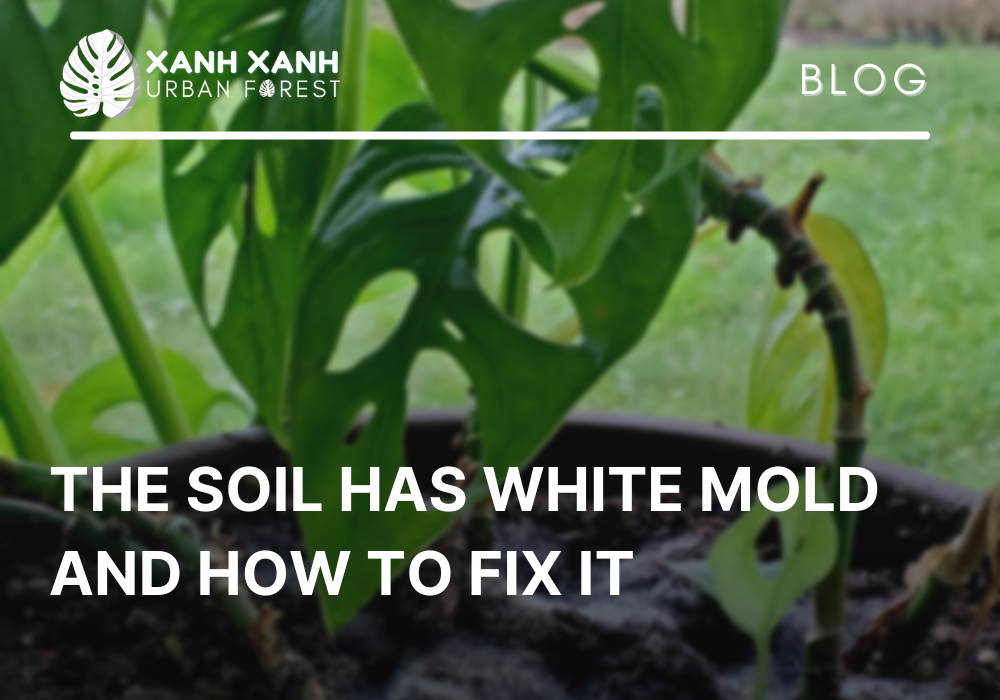A saprophytic fungus that grows on the surface of houseplant potting soil is usually a white mold. Despite the fact that the fungus does not harm the plant, it is unattractive and suggests a problem. People who water too much, don’t let their plants dry out, and use potting soil that’s been used before are all good places for saprophytic fungus to grow, but they also make it more likely.

Overwatering
Any excess water left in a potted plant will be consumed by fungus, and too much water might cause root rot. Houseplants, on the whole, require less water than their counterparts outside. While direct sunlight and wide-open spaces cause outside plants to dry up rapidly, indirect sunlight and enclosed rooms within a home help plants retain water for extended periods of time.
Poor Air Circulation
Indoor plants cannot always get enough air circulation, especially when the windows are closed in the winter. Plants maintained in dark corners or on crowded shelves are especially vulnerable to this problem. Air movement aids in the drying of plants between waterings.
Contaminated Soil
Mold might be a concern in your potting soil. While soil should contain some microbes, it might get polluted before it even reaches a pot.
Decomposing Leaves on Surface
Mold and other fungal illnesses feed on decomposing plant matter, so an accumulation of dead leaves in the soil will promote mold growth. Remove the plant’s dead parts before they build up at the base. To reduce yard trash, utilize fallen leaves as mulch.
How Can I Prevent New Mold from Growing?
Cleaning Up the Mold
In most circumstances, scraping the mold off the soil surface and placing the pot in an appropriate, well-ventilated area will ensure that the soil dries. If the mold comes back or the soil stays wet, you might want to repot the plant with new, sterile potting soil.
Remember to soak the pot in a solution of 1 part household bleach to 9 parts water for about 10 minutes before using it again. Scrub it with a mixture of water and dish detergent.
Drainage is essential to prevent white mold.
Even the best watering technique in the world won’t keep your soil from being soggy if it can’t drain properly. Every plant container should have holes on the bottom, and the container should rest on a removable saucer to catch the water as it drains from the pot.
Additionally, you can improve drainage by inserting broken crockery or a layer of small stones at the bottom of your pot, which will prevent soil from filling the holes again. A 6-inch pot usually requires 1 inch of pebbles, while a 12-inch container requires at least 2 inches. Always inspect the holes to make sure they aren’t blocked on a regular basis.

Potting Soil
Choose a good quality potting soil that has a combination of decomposed plant material such as bark, perlite or sand, and peat moss.
Other things may be in potting soil, but these three things are the foundation for potting soil that can keep the plant alive and let water drain freely.
However, make sure your potting soil is clean and free of insects and pathogens such as fungi. Contaminated potting soil has a distinct sour odor that is easy to identify.
Because open bags of moist potting soil can serve as breeding grounds for insects and germs, sealing the bag before storing the unused portion is a good idea.
Even the best potting soil has a shelf life of about a year or two. And because it can’t handle water well once it starts to break down, the soil will wind up retaining too much moisture.
To avoid this, repot your plants every two or three years to ensure that the soil is refreshed and the drainage is improved.
If you don’t want to deal with the mold on your own, there is one established approach that will entirely eliminate the problem: repotting your plant in fresh, sterile soil, guaranteeing that the old, infected soil is no longer there.
Protect houseplants with an anti-fungal spray
In some situations, the soil may require assistance in fighting mold and fungus. If you live in a wet or cold place, it may be difficult at first, but using a natural antifungal and applying it to the soil will help a lot.

There are a number of effective natural antifungal treatments. Apple cider vinegar, cinnamon, and baking soda are all excellent choices. And, as long as you don’t overuse them, none of them will ever hurt your houseplant.
You can either mix them into the soil or sprinkle them on top of the soil of your houseplant. However, be careful not to overdo it, as too much of it can harm the soil. It just takes a few sprinkles or a few spoons per houseplant, so keep these proportions in mind.
As can be seen, there are numerous efficient methods for ensuring that both your plant and the soil are free of white mold. And by following these steps when you care for your plants, you can be sure that they will stay beautiful and healthy, adding beauty and harmony to your surroundings.

